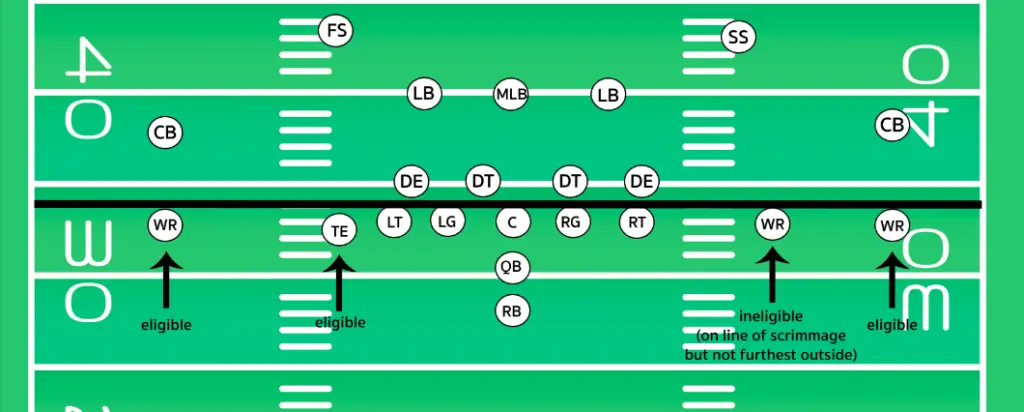An ineligible receiver downfield penalty occurs when a player who is not allowed to catch forward passes travels at least one yard past the line of scrimmage without blocking an opponent.
In the NCAA ineligible receivers must travel three yards downfield for this penalty to be called.
The outcome of this penalty is a loss of five yards from the previous spot.
This penalty is enforced because allowing ineligible players downfield makes it incredibly hard for the defensive players to know which players they have to cover.
To learn more about the effect of penalties like an ineligible receiver downfield see our guide to offsetting penalties in football.
What to know
Eligible receivers
If you are just learning about this penalty the first thing you need to understand is what an eligible receiver is.
In the game of football, only players who line up off the line of scrimmage or on the end of the line of scrimmage are eligible receivers.

There needs to be a minimum of at least seven players on the line of scrimmage for the offense.
The two wide receivers are usually on the end of the formation and on the line of scrimmage. Since these players are the two players on the end of the line they are eligible.
Slot receivers, running backs, and tight ends will often line up one yard off the line of scrimmage in order to remain eligible.
Offensive linemen on the other hand are on the line of scrimmage but not on the outside of the formation. This means they are not eligible. Being on the line of scrimmage yet not on the outside is referred to as being covered up.
Blocking downfield
The next thing you must know about ineligible receiver downfield penalties is that they are only called if the receiver is not blocking.
On a passing play, an ineligible offensive lineman is allowed to block an opponent and push him down the field. If this lineman travels a yard past the line of scrimmage it is legal because he is in the process of blocking.
If the lineman headed that far downfield without blocking then a penalty will be called.
Now say the lineman blocks a player downfield and then the defender is able to get away. In this situation, the lineman must stay stationary in order to avoid an ineligible receiver downfield penalty.
If the lineman continues towards the opponent’s goal line after the block then he will be called for a penalty.
Exceptions to the rule
When you see an ineligible receiver downfield penalty called it is almost always an offensive lineman that has made his way downfield.
But at the same time, there have been many plays in which an offensive lineman has caught a pass in the NFL in recent years.
The reason this is allowed is that these linemen were eligible receivers. As we stated earlier the players on the end of the line of scrimmage are eligible receivers.
Generally, this going to be the wide receivers lined up near the sideline. But if there is no player outside the offensive tackle on the line of scrimmage this player can become eligible.
To become eligible as an offensive lineman you must declare it to the official. The official will then announce that the lineman is eligible for the play due to the formation.
In this situation, this player can travel as far as he wants downfield as he is now an eligible receiver.
Why do they call this penalty?
Oftentimes when you see this penalty called in football it will seem like it had a direct effect on the play. This leaves many fans annoyed with this rule.
The reason that this rule must be enforced is that without it defenders would have way too many players to cover.
Though these players are not eligible to catch a pass defenders are not going to be able to identify them that quickly.
Without this rule, all five offensive linemen could run downfield with the receivers making it incredibly difficult to determine which players are eligible to catch a pass.
Since defensive backs are used to covering three or four receivers on a play this rule had to be put into place. Though it can be annoying when called against your team the ineligible receiver downfield penalty is an important rule.
